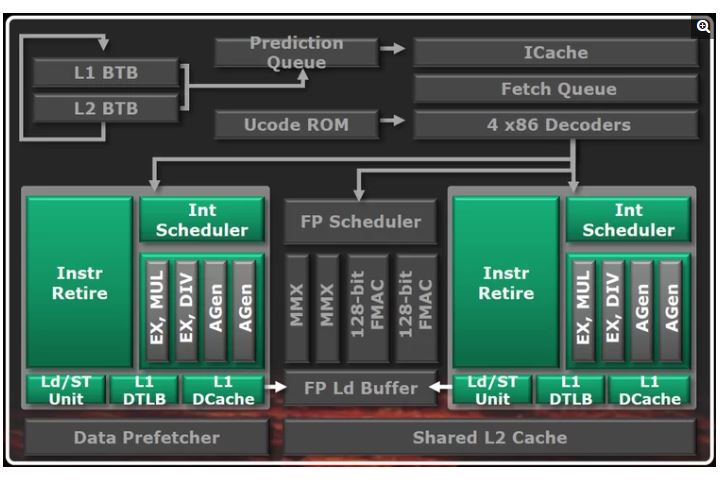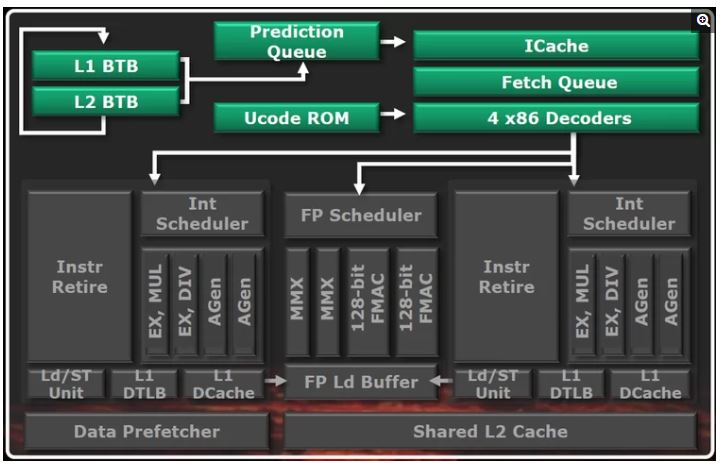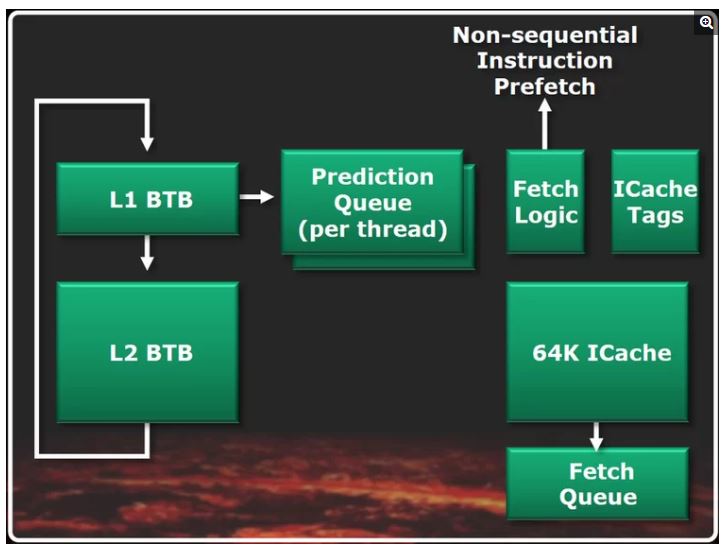AMD Settles FX Bulldozer False Advertising Lawsuit for Roughly $35 a Chip
Today, AMD has settled a class-action lawsuit for false advertising of its Bulldozer chips for a total of $12.5 million, of which lawyers could take up to 30%, or $3.63 million. That could leave an $8.87 million pot for Bulldozer owners to split among themselves (provided they file a claim).
AMD's Bulldozer lineup of chips, which debuted back in 2011, were largely considered a flop due to their high power consumption, inability to hit rated boost speeds, and generally lackluster performance in comparison to Intel's competing Sandy Bridge chips. Thus, Bulldozer is largely credited as the chip that touched off AMD's decline in the desktop PC processor market, which eventually found the company teetering on the edge of bankruptcy. That situation wasn't rectified until the arrival of the Ryzen series of chips in 2017.
To make matters worse for the then-embattled AMD, the company advertised the chips as eight-core models, when in fact they featured four modules that each had two execution cores with shared resources, like a shared front end, cache, and floating point unit, meaning the cores were incapable of operating independently. AMD maintained that the dual-core modules still met the definition of two traditional cores, but some customers disagreed.
That led to a long-running class-action false advertisement lawsuit that was filed in 2015, but AMD settled the lawsuit today for a paltry $12.1 million. The settlement works out to roughly $35 a chip, provided that the number of claimants meets the projections of the court. Unfortunately, the court only predicts that 1/5th of the customers that purchased a Bulldozer chip will come forward to claim their settlement.
As with any settlement that is tied to a lump-sum payment from the defendant, that number could shrink if more people come forward to claim the cash payout. If you purchased any of the seven Bulldozer models from AMD's website or in California, you are entitled to your slice of the settlement pie.
AMD seems to have gotten off lightly, as damages could have been much higher if the settlement had proceeded to court. From the filing:
The value of the proposed common fund represents a recovery of approximately 20% of the damages Plaintiffs would have sought to prove at trial on behalf of the certified class. And, based on their experience, Class Counsel estimate that claiming class members are likely to receive more than 50% of the value of their certified claims had they prevailed at trial. Given the risks and expenses that further litigation would pose in this case, such a result is well within the range of approval
Get Tom's Hardware's best news and in-depth reviews, straight to your inbox.



Here we can see the crux of the debate about AMD's Bulldozer marketing. Each module's front end resources, in gray at the top of the first graphic, are shared between two integer cores (marked in green). The floating point unit (FPU) resides between the two integer cores but provides the only floating point processing for the entire module. The L2 cache is also shared between all three functional units. Combined with the shared prediction queue and instruction/fetch caches, the integer cores cannot operate independently of one another.
| Model | Base Clock | Turbo Core Clock | Max. Turbo Core | TDP | Cores | Total L2 Cache | Shared L3 Cache | Northbridge Freq. |
|---|---|---|---|---|---|---|---|---|
| FX-8150 | 3.6 GHz | 3.9 GHz | 4.2 GHz | 125 W | 8 | 8 MB | 8 MB | 2.2 GHz |
| FX-8120 | 3.1 GHz | 3.4 GHz | 4.0 GHz | 125 / 95 W | 8 | 8 MB | 8 MB | 2.2 GHz |
| FX-8100 | 2.8 GHz | 3.1 GHz | 3.7 GHz | 95 W | 8 | 8 MB | 8 MB | 2.0 GHz |
| FX-6100 | 3.3 GHz | 3.6 GHz | 3.9 GHz | 95 W | 6 | 6 MB | 8 MB | 2.0 GHz |
| FX-4170 | 4.2 GHz | - | 4.3 GHz | 125 W | 4 | 4 MB | 8 MB | 2.2 GHz |
| FX-B4150 | 3.8 GHz | 3.9 GHz | 4.0 GHz | 95 W | 4 | 4 MB | 8 MB | 2.2 GHz |
| FX-4100 | 3.6 GHz | 3.7 GHz | 3.8 GHz | 95 W | 4 | 4 MB | 8 MB | 2.0 GHz |
Here we can see the specs of the FX Bulldozer processors that were advertised with either four, six, or eight cores. Below we can see the launch pricing for the chips, which weighed in at $205 and $245 for the eight-core models. Even if the settlement pays out the estimated $35 per chip, and it likely won't, that is only a fraction of the original MSRP.
| Model | Base Clock | Turbo Core Clock | Max. Turbo Core | TDP | Cores | Suggested Price (U.S) |
|---|---|---|---|---|---|---|
| FX-8150 | 3.6 GHz | 3.9 GHz | 4.2 GHz | 125 W | 8 | $245 |
| FX-8120 | 3.1 GHz | 3.4 GHz | 4.0 GHz | 125 W | 8 | $205 |
| FX-6100 | 3.3 GHz | 3.6 GHz | 3.9 GHz | 95 W | 6 | $165 |
| FX-4100 | 3.6 GHz | 3.7 GHz | 3.8 GHz | 95 W | 4 | $115 |
As this settlement was agreed upon today, there isn't a mechanism to secure a refund yet. We'll update this post as necessary as more details come to light.

Paul Alcorn is the Editor-in-Chief for Tom's Hardware US. He also writes news and reviews on CPUs, storage, and enterprise hardware.
-
TheSecondPower This seems pretty rediculous. There are way bigger exaggerations in other product markets. And if people get at most $35 per chip, they gain almost nothing; just a waste of their time. The consumers lose, AMD loses, everyone loses. Except the lawyers apparently.Reply -
GetSmart Nopesies, the consumers win not from the financial standpoint but from the use of the term core which cannot be simply applied to CMT (clustered multi-threading) clusters. Thus no more misleading advertizing or marketing of multi-threaded CPU core designs.Reply -
jimmysmitty ReplyGetSmart said:Nopesies, the consumers win not from the financial standpoint but from the use of the term core which cannot be simply applied to CMT (clustered multi-threading) clusters. Thus no more misleading advertizing or marketing of multi-threaded CPU core designs.
Pretty much this. AMDs Bulldozer uArch was just CMT, which is a much more resource inclusive version of SMT. Both ideas came from the same place technically, DEC. Intel went the SMT route but marketed their chips accordingly as cores and threads. I think if AMD did the same, stating that it was 4 modules and 8 threads instead of 8 cores they would have avoided this altogether.
I am not surprised that they settled. This happens most often as it is probably cheaper to settle and pay out than to drag it out in years of court to potentially lose and have to pay even more.
I doubt we will see more CMT designs in mainstream with more and more cores coming to mainstream though. -
GetSmart Reply
Well, IBM's Power also marketed their SMT as it is (like Intel). That "module" definition was AMD's own marketing term as well. In reality the "module" is the actual core, while the "cores" are actually clusters.jimmysmitty said:Pretty much this. AMDs Bulldozer uArch was just CMT, which is a much more resource inclusive version of SMT. Both ideas came from the same place technically, DEC. Intel went the SMT route but marketed their chips accordingly as cores and threads. I think if AMD did the same, stating that it was 4 modules and 8 threads instead of 8 cores they would have avoided this altogether. -
Gam3r01 Im sure almost nobody will pay attention to the part where you had to buy it from AMDs website (or california?) to quality for the payment.Reply -
jimmysmitty ReplyGetSmart said:Well, IBM's Power also marketed their SMT as it is (like Intel). That "module" definition was AMD's own marketing term as well. In reality the "module" is the actual core, while the "cores" are actually clusters.
Agreed but even IBMs Power SMT is more like Intels than like AMDs.
Their marketing team screwed them really.
Gam3r01 said:Im sure almost nobody will pay attention to the part where you had to buy it from AMDs website (or california?) to quality for the payment.
I wonder if that will stick. How many people ordered it directly from AMD? I doubt the vast majority did.
But this does open them up for more lawsuits for other states. I doubt they will nor do I think they should. I really think this one is stupid TBH but its how the world works these days. Obviously they guy had major losses from this. Yup. Major losses from a CPU that didn't quite perform as well as modern 8 cores. -
jimmysmitty ReplyAlistairAB said:So how about Ryzen "cores" that don't work without the I/O die?
Not really the same as none of the parts taken from the CPU and put onto the I/O die are part of the core itself. They took basically the USB, PCIe and IMC and put it onto the I/O die and connected the CPU cores to it. Think of it as the old school Northbridge but vastly faster, fast enough that you don't lose performance.
Before Intels Nahelm or AMDs K8 uArchs the CPU cores were just cores and were connected to the Northbridge which had the memory controller and some I/O. This is essentially what AMD did to offload some power and heat from the cores themselves but it is not comparable.
Bulldozer had 2 threads per module but unlike say an Athlon X2 or Intel Core 2 Duo it shared certain resources that the latter had for each core individually.
Basically all this covers is the Bulldozer and Piledriver uArch. -
paul prochnow I had a FX4170---how do I show I did. It is long ago.Reply
Some of these Class Actions are lax---so, I wonder. -
bit_user Reply
You probably need the receipt. If you can at least find the credit card statement, that might be a start. Then, maybe you can contact the retailer and see if they had any record of the transaction.paul prochnow said:I had a FX4170---how do I show I did. It is long ago.
Some of these Class Actions are lax---so, I wonder.
